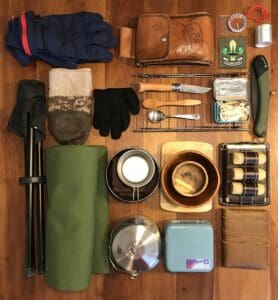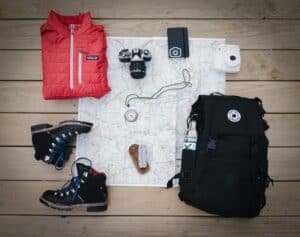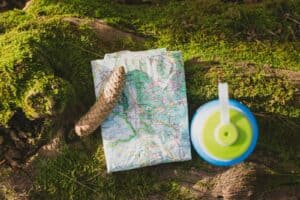Embarking on a big hike soon? I’ve got you covered. What to bring on a big hike? In this article, I’ll be sharing essential items you shouldn’t leave behind. From survival gear to snacks, we’ll delve into everything you need to pack.
Hiking is more than just a walk in the woods. It’s a test of endurance, a journey into the unknown, and an opportunity to reconnect with nature. But without the right gear, it can quickly turn into a challenging ordeal.
Why Proper Gear is Essential for a Big Hike

Embarking on a big hike is an adventurous endeavor that takes more than just the desire to connect with nature. Having the right gear plays a crucial role in defining your overall hiking experience, not only making it enjoyable but also helping ensure your safety.
First, let’s contemplate the role of clothing and footwear. Quality hiking clothes and boots safeguard you against the elements. Imagine being caught in a downpour without a waterproof jacket or trudging through rugged terrains without sturdy boots. That’s right—hardly ideal. High-quality hiking garments are designed to protect you against extreme weather conditions and fortify you against harsh terrains.
Next, let’s talk about survival gear. On a big hike, it’s essential to be equipped with some basics such as:
- A first-aid kit
- A flashlight or headlamp
- A reliable navigation tool
These items could make a significant difference during emergencies. In the vast wilderness, you never quite know what might happen. Your gear is your ticket to getting through any unforeseen challenges unscathed.
Food and water are also of undeniable importance. I’ve learnt from experience that even those who deem themselves as ‘light-eaters’ can work up a mean appetite after a few miles. Packing right with lightweight yet nutritious snacks and ample water (including means for purification) becomes your lifeline in the wilderness.
A lighter load says ‘ease’; a heavier load screams ‘preparedness’. In the intimidating vastness of the outdoors, I’d rather be prepared than relaxed. The key is to strike a balance – carry the essentials, but not at the cost of overburdening yourself.
So the next time you’re planning a big hike, remember – it’s more than a walk in the woods. Proper gear is essential to navigate your journey, come what may! Play it smart – gear up right, and let your adventure shine bright.
Clothing and Footwear for a Big Hike
Selecting the appropriate clothing and footwear for a big hike is critical. It not only protects against harsh climate conditions but can also significantly impact comfort and performance. Let’s shed some light on what I consider indispensable when it comes to hike-ready clothing and footwear.
Dressing in Layers: I’ve always stressed the importance of layering up. And with good reason! Temperatures and weather conditions can change drastically during a hike. Starting with a moisture-wicking base layer that’ll keep you dry is fundamental. Mid-layers should offer insulation, keeping you warm. Lastly, a waterproof, breathable outer layer serves as a shield against rain and wind.
Choose Breathable, Quick-Dry Fabrics: Fabrics that are quick-drying, moisture-wicking, and breathable are indispensable. I’ve found materials like synthetic blends and merino wool to perform exceptionally well. More traditional fabrics like cotton do a poor job at thermal regulation and take forever to dry – let’s keep those for the after-hike party!
Boots Make a Difference: I can’t emphasize enough – investing in a good pair of hiking boots makes all the difference. You want something sturdy that provides ankle support and has a great grip on slippery terrains. And let’s never forget – breaking in your boots before the hike is super important.
Socks Matter, Too: Socks, the unsung heroes of hiking. Quick drying, cushioned, and breathable socks can significantly enhance foot comfort and prevent blisters.
Headgear Keeps You Covered: A hat or a beanie can protect against sunburn, cold, and wind. If it’s sunny, a hat with a wide brim is your best friend. For colder temperatures, a beanie can keep your head and ears warm.
Essential Survival Gear for a Big Hike

In addition to suitable hiking attire, it’s critical to carry some essential survival gear that will ensure your safety and comfort. Pack light, but don’t miss any necessary items. Here are my top recommendations for any big hike.
A reliable multi-tool should be at the top of your ‘must-have’ list. This versatile piece of equipment offers numerous functionalities that can make your hiking experience easier and safer. Be it a knife, scissors, or a bottle opener, a multi-tool does it all! One of my favorites is the Leatherman Wave Plus, known for its durability and variety of tools, it’s a lightweight option that suits all types of outdoor adventures.
Next on the list is a strong, lightweight, and waterproof tent or bivy sack. Weight and comfort are key considerations when choosing suitable accommodations. MSR Hubba Hubba NX2 is a lightweight freestanding tent that also boasts two doors, making it a choice option for multi-day hikes. A bivy sack, on the other hand, may not offer the roominess of a tent but provides exceptional warmth and weatherproof protection. The Outdoor Research Helium Bivy comes highly recommended, particularly for hikers wanting to travel light.
Bring along a first aid kit. I always advise setting up your own customized kit catering to your unique hiking needs. However, for first-timers or those wanting a quick solution, the Adventure Medical Kits Ultralight is a compact, comprehensive kit packed with bandages, medications, and antiseptic wipes.
You’d also need a high-energy, easily portable food source. Energy bars, trail mix, and freeze-dried meals are popular choices. These foods can provide a quick calorie boost without the hassle of cooking. Clif bars and Mountain House freeze-dried meals are some reliable options that cater to diverse taste preferences.
Navigation Tools for a Big Hike
Never taking chances when I’m hiking deep into the wilderness is my mantra. Unequivocally, a robust set of navigation tools becomes essential. For a safe and enjoyable hike, having tools such as maps, a compass, and a GPS device is crucial in case of an unplanned detour or getting lost.
Printed topographic maps should be your first ally in the wild. The advantage? They run without a battery. Intimate knowledge of the terrain helps reduce anxiety and uncertainty out there. And the best part, they’re often waterproof!
Aside from maps, a compass is another quintessential tool, rendering it incredibly useful if your electronics fail. It’s lightweight, easy to pack, and requires no battery. Bear in mind, mastering how to use it is paramount. Otherwise, it’s just dead weight!
To complement the traditional compass-and-map combo, a GPS device can be a lifesaver, literally. These devices provide your exact location, the direction you’re headed, and the route you’ve tracked. Ideal for when you’re navigating unfamiliar terrains. Preferably, get a model designed for hiking, as they’re typically more robust and weatherproof than simple car GPS units.
Additionally, carrying a portable battery or a solar charger to keep your electronics juiced up is worthwhile. Solar chargers are gaining popularity for long-distance hikers due to their lightweight and renewable energy source.
It’s clear that technology has it’s part to play for speedy rescues and easier navigation. However, relying solely on it is risky. Remember, gadgets can fail. Batteries die. Signals may be lost. So, don’t neglect the good old fashion compass and map.
Remaining vigilant and well-prepared with reliable navigation tools not only minimizes the risk of getting lost but also makes the hike much more relaxing and enjoyable. It’s all about making your big outdoor adventure safer and more manageable.
Hydration and Nutrition Tips for a Big Hike

Closely tied to your hiking gear, hydration and nutrition play a paramount role in your preparedness. They’re just as essential as your compass or map, a vital part of the equipment that’ll ensure a successful and enjoyable hike.
First on the list? Water. Without it, all other measures fall short. It’s recommended to drink about a half liter of water per hour of hiking. Variables like climate, altitude, effort level, and individual needs can impact this, but as a general rule, half a liter per hour works for most hikers. Pack a refillable water bottle or a hydration bladder. No one wants to deal with dehydration 10 miles from the nearest water source. Lightweight water purification solutions – such as chlorine dioxide tablets or a small water filter – can be a lifesaver if you find yourself out of water.
Next up we have nutrition. You need to recharge your energy levels with high-quality foods. Choose non-perishable, nutrient-dense items. Aim for slow-burning carbs, fats and proteins. Favorites among hikers are nuts, dried fruits, beef jerky, whole grain bars, and peanut butter.
It may sound counterintuitive, but you also need salts and minerals. When you’re sweating, you’re not only losing water but electrolytes. This can lead to decreased performance, muscle cramps, and in severe cases even heat stroke. Including electrolyte replacement solutions, like specially-formulated powders or tablets, in your gear can help prevent these issues.
Looking at calorie count, you may burn between 3000 to 6000 calories a day on a serious hike, depending on weight, pace, and terrain. Thus, packing high-calorie foods is crucial.
A hike isn’t just the kilometers you cover or the summits you conquer. Much of it centers around maintaining the fire – the metabolic engine – that powers you through. With knowledge on how to increase water intake and balance your nutrients, you’ll be ready and able to tackle any trail.
Conclusion: What to Bring on a Big Hike
As we’ve delved into the essentials of big hike readiness, we’ve seen how vital proper clothing, footwear, and survival gear are. But let’s not forget about the crucial role of hydration and nutrition. I can’t stress enough the importance of carrying a refillable water bottle or hydration bladder. Plus, consider adding lightweight water purification solutions to your pack.
When it comes to food, high-quality non-perishable items packed with slow-burning carbs, fats, and proteins should be your go-to. Don’t underestimate the power of electrolytes and high-calorie foods for maintaining your energy levels.
Remember, a successful hike isn’t just about reaching the peak. It’s about the journey, and being well-prepared can make that journey enjoyable and safe. Happy hiking!


